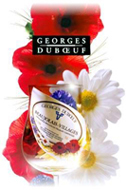![]()
Recent Articles
Archive of National Post Articles
![]()

Time
to Cruise Beaujolais Crus
©
Georges
Duboeuf’s 1999 Sampler Pack
© Michael
Vaughan 2001
National Post Weekly Wine & Spirits
Columnist
Saturday,
July 21, 2001
 Those yearning to
explore the totality of flavours a region can offer need not wait any
longer. This month’s Vintages release offers the perfect opportunity for
the budding oenophile. It’s a mixed 12-pack of Beaujolais. And it’s
not just any Beaujolais, but a special selection from every region
selected by the king himself Georges Duboeuf. Indeed, every wine (with the
exception of one) comes from an individual Château or Domaine!
Those yearning to
explore the totality of flavours a region can offer need not wait any
longer. This month’s Vintages release offers the perfect opportunity for
the budding oenophile. It’s a mixed 12-pack of Beaujolais. And it’s
not just any Beaujolais, but a special selection from every region
selected by the king himself Georges Duboeuf. Indeed, every wine (with the
exception of one) comes from an individual Château or Domaine!
At $199.00, the Duboeuf Beajolais Crus Sampler Pack
is available by calling Vintages at 1-800-266-4764. Only 300 cases are
still available meaning that fans should act quickly.
Now some naysayers may
feel that wines from this region are passé, lacking the complexity and
density of say Bordeaux. But hey, it’s the summertime when a comparative
tastings of heavier reds doesn’t quite have the same cache as it does in
winter. Being lighter, fruitier and capable of slight chilling is a
definite benefit at this time of year.
And so, I ventured forth
to conduct a comparative blind tasting of all twelve – from a Beaujolais
and Beaujolais Villages through all ten communes starting with the
lightest and ending with the most robust. Keep in mind that all these
wines are 100% Gamay, most of which is not subjected to barrel aging.
Thus, freshness and fruit are the essence of the equation, not complexity
Of course, the key
question is: what are they like? In a word – accessible. One of the
major problems with cru Beaujolais is that they can be very peppery and
rather tart when young. No so with the 1999 vintage at Duboeuf. On August
15th, after a lousy, cool, rainy summer, the skies cleared.
“For the next four weeks, the dry winds and sunny, warm weather enabled
our grapes to ripen perfectly,” says Georges’ son Franck. (www.duboeuf.com)
Rather than give a
blow-by-blow detailed tasting note for each wine (available on my
website), I am providing a few highlights on each wine presented. Before
going there, however, let me lodge a complaint. It concerns Duboeuf’s
inclusion of a quasi-generic illustrated sheet of the 10 Crus presented.
Trouble is, none of the labels presented are in the case! Surely, a
detailed list with actual domaine names of wines presented would be in
order (also posted on my website). It would save a lot of writing and
actually be worth keeping!
 According to Tom
Stevenson author of The
New Sotheby’s Wine Encyclopedia, the world is awash in mediocre
Beaujolais. “The problem is that
… the majority of it, including bad Cru Beaujolais, smells of bubble gum
or bananas and tastes of peardrops. The trade calls it “lollipop” wine
and it is ideal for anyone who does not actually enjoy the characteristics
of real wine.” While some Vintages items have unfortunately fallen
into this category, Duboeuf’s wines are a definite notch above the norm.
Even Robert Parker is “impressed both by the overall quality (…he
sells 1.2 million cases in the US alone) and by their excellent value.”
According to Tom
Stevenson author of The
New Sotheby’s Wine Encyclopedia, the world is awash in mediocre
Beaujolais. “The problem is that
… the majority of it, including bad Cru Beaujolais, smells of bubble gum
or bananas and tastes of peardrops. The trade calls it “lollipop” wine
and it is ideal for anyone who does not actually enjoy the characteristics
of real wine.” While some Vintages items have unfortunately fallen
into this category, Duboeuf’s wines are a definite notch above the norm.
Even Robert Parker is “impressed both by the overall quality (…he
sells 1.2 million cases in the US alone) and by their excellent value.”
Starting with regular 1999 Beaujolais Chateau de Vernay,
this medium-light bodied red showed good Gamay typicity with some crisp,
red fruit flavours. It was the lowest in alcohol with 12% and, like most
these 1999’s, surprisingly rounded and accessible. Next came the
slightly deeper coloured 1999
Beaujolais Villages Chateau de Varennes with 12.5% alcohol. It
scored slightly higher with some peppery, framboise eau-de-vie flavours.
Moving on to the most
recently designated cru, the usually light-bodied, fragrant Régnié that
is meant for immediate consumption. Unfortunately, the
1999 Régnié Domaine du Potet showed
some reedy, slightly tart, green apple notes. Ok but no detour (although
it improved with breathing).
By contrast, the 1999 Chiroubles Domaine Desmures showed
quite nicely with spicy, bright, fragrant raspberry flavours. It’s the
lightest in colour and is somewhat thinner than the rest, so drink up and
enjoy.
Brouilly is the largest
and most southerly of the cru and this 1999
Brouilly Chateau de Nevers is rather richer and more robust
than the predecessors with cooked strawberry and dried raspberry flavours.
A fine wine for a robust cassoulet.
One of my highlights was
from the higher altitude vineyards of 1999
Côte de Brouilly Domaine de la Madone which I feel epitomized
what a great cru Beaujolais is all about. It has a lovely, zingy, black
raspberry nose and tangy, well proportioned, fresh apple and red pepper
purée flavours which show good length.
The 1999
Juliénas Chateau des Poupets was not my favourite in the blind
tasting with its youthful, robust, slightly tart, reedy, dried sour apple
flavours. Having said that, I have to admit that it was one of the
favourites for one taster.
Moving on to the most
northerly of the ten cru, 1999
Saint-Amour Domaine de la Pirolette has robust, rather chalky,
tea and plum flavours that would make it a candidate for boeuf
bourguignonne.
The fairly rich and
rounded 1999
Morgon Domaine Jean-Ernest Descombes is not quite up to some
previous shipments. The plummy fruit was there, but the berry tones were
muted. Look for a hint of peach on the nose.
From the smallest cru,
the tasty, albeit still youthful 1999
Chénas Domaine des Dorroux impressed with its dried cherry and
beefsteak tomato flavours. A perfect foil for grilled meats.
As for the 1999 Fleurie Chateau des Déduits,
instead of being floral with hints of violets, it was rather earthy with
some prune notes suggesting that it may have been an off-bottle.
The last, the voluptuous
13% alcohol 1999
Moulin à Vent Aged in oak for 6 months is best of all, albeit
least Beaujolais-like! It has a complex, slightly cedary nose and creamy,
forward, remarkably rich, plum, pomegranate and lime purée flavours that
show great length. A marvelous example to toast the 75th
anniversary of this great cru.
Upcoming: Starting Monday, July 23rd the LCBO delistings saga continues with 20% savings (paid for by the suppliers, not the LCBO). Details of all 29 brands being delisted (most of which are liqueurs) is available on my website. Click Here

European Reporter
March 2000 Issue
Duboeuf
~ The King of Beaujolais
By Michael Vaughan
The History
As Caesar's army
crossed the Alps and into Gaul in the 1st century B.C., they built
temples, aqueducts, amphitheaters and roads. Along those roads, Rome's
army planted the vine. There is still evidence of these Roman vineyards to
be found in the Beaujolais towns of Brouilly and Morgon. After the Romans
departed, the area was invaded by the Barbarians and then the Arabs, who
also tended the vines and enjoyed its fruits.
Founded in the 10th century by the powerful nobility that created
the principality, the town of Beaujeu in the western hills of Beaujolais
gives the region its name.
It was ruled
by the Dukes of Beaujeu until it was ceded to Bourbonnais in 1400. The
region really began to develop an identity distinct from its northern
neighbor, Burgundy, after Philippe the Bold made his famous decree of July
1395. The monarch outlawed the planting of the Gamay grape and forbade its
cultivation in the region of Burgundy. So Burgundy selected Pinot Noir and
Beaujolais kept the Gamay. Although the edict was not at all popular with
the medieval grape growers, it proved to be a good thing for both areas.
Here in Beaujolais, the Gamay (Gamay noir au jus blanc) succeeds like
nowhere else.
The
Region
The Beaujolais region is located south of the city of
Macon and north of France’s gastronomic capital, Lyon. It is a
prosperous region with 55,000 acres under cultivation by 9,500
winegrowers. The entire region produces 13 million cases annually.
This 34-mile strip of rolling hills along the Saone River is
geographically, but it is unified by the Gamay Noir grape. Ninety-eight
per cent of the area is planted with it. The other 2% is comprised of
Chardonnay and Pinot Noir. The
soil in Beaujolais can be clay, chalk, schist or granite. It is this
variation as well as the vineyard’s microclimate and elevation that
accounts for the flavor differences found in the various appellations or
crus.
The
Vineyards
As the market for wines grew, new vineyards were
planted away from the small towns and villages and on better soils with
exposures of the hill slopes. Now these "soil zones" of
Beaujolais were beginning to take shape. Comprised of 12 appellations,
Beaujolais is divided into 3 categories or levels of quality – the basic
quality Beaujolais; Beaujolais-Villages and the crus of Beaujolais.
About half of all Beaujolais produced, approximately 7
million cases a year is sold as basic Beaujolais. This is wine from grapes
grown in rich limestone/clay with occasional sandy patches in the flat
plains of the southernmost region called Bas-Beaujolais. The minimum
alcoholic degree is 9. These flowery and fruity wines must be drunk young,
as they are not intended for keeping.
With a minimum of 10 degrees of alcohol,
Beaujolais-Villages is the next level.
Wines bearing the Beaujolais-Villages label are restricted to using
grapes coming from at least 2 of the 39 communes in Haut-Beaujolais where
the soil has lighter granite and schist based sandy texture, which makes a
better wine. These wines account for about a quarter of the total annual
production of this region. Due
to better growing conditions, these are more desirable wines, noted for
substantial complexity and depth. They can be kept from one to three
years.
Within the northernmost part of this region are the 10
crus – Saint-Amour,
Julienas, Chenas, Moulin-a-Vent, Chiroubles, Morgon, Regnie, Brouilly, and
Cote Brouilly – that have been singled out and named due to
their distinctive characteristics, a result of both soil and microclimate,
since the grape is the same for all. Keep in mind that these are
generalizations and there are wide variations of style relating to the
specific site, producer and vintage. Brouilly is said to be grapey, while
Fleurie is described as having the aroma of violets and Saint-Amour of
peach. Brouilly, Cote Brouilly, Fleurie, Saint-Amour, and Chenas all share
a common elegance and fragrant delicacy, whereas Julienas, Morgon, and
Moulin-a-Vent, are fuller, have deeper flavor and more lasting power.
Chiroubles is the highest in altitude of the Cru wines and is the
most balanced. The wine made here is highly sought after for its texture
and suppleness. From the village of Chiroubles came Victor Pulliat who, in
1888, perfected the technique of grafting French vines onto American
rootstock, thus saving the vines of France. Regnie is the most recent of
the Beaujolais wines to be assigned the prestigious crus status, joining
the others in 1988. Perhaps
the most famous of the crus is Moulin-a-Vent. The name comes from an
ancient windmill built on the hill surrounding the town of
Romaneche-Thorins. Its great aging potential and exceptional quality is
attributed to the granite subsoil of the area. Chenas is next door to
Moulin-a-Vent, this is a heady wine can be enjoyed young or laid down.
The
House of Duboeuf
Georges Duboeuf was born in 1933 in Chaintre, a
village in the region of Pouilly Fuisse into one of the oldest winegrowing
families in the region. His ancestors were already cultivating vineyards
in the 18th century. At the age of five years he was already participating
in his first vintage!
At nineteen years old he abandoned his studies in
order to devote him entirely to the family vineyard. He marketed the wine,
which he had personally bottled and proceeded to visit all the restaurants
in the region. As a result of this success with these wines he invented
the profession of "manufacturer-bottler" from home, and created
a group of producers called "I'Ecrin Maconnais Beaujolais."
For Georges Duboeuf, “Bottling is a delicate technique. It is necessary to proceed swiftly,
undertake the work at a specific time and in a completely hygienic
environment. The bottling is a job that is as sensitive as that of the
winegrower. It requires stringency, precision, hygiene, and method. This
is a most delicate operation, for bottling is, in reality, the
conservation of a great masterpiece since it seals in the result of a
year's work. The entire work of the winegrower is embodied in the wine
which he entrusts to us for the final act.”
Next came his marriage to Rolande as well as the birth
of their two children Fabienne and Franck. In September 1964 the Limited
Company "Les Vins Georges Duboeuf’ was formed. From the very
beginning, he built on his reputation in restaurants of high quality, and
it was in this way that his wines won the approval of the great chefs,
Paul Blanc, Paul Bocuse as well as others.
The first time that the wines of Georges Duboeuf were
really honored was at the occasion of the Universal Exhibition in Montreal
in 1968 when Raymond Oliver asked Georges Duboeuf to supply the wine for
the French Pavilion. This was the start of his international fame. The
Swiss came first, followed by the Germans, the Dutch, the Belgians and the
English. He went onto to market Beaujolais throughout the world, and has
remarked “Our passion for wine it
is first trying to understand it, to love it and to cherish it. Our
profession is to invite the greatest number of people possible to share
our joy and at the same time to explain the role of the magic of wine,
symbol of a dream, bearer of good cheer, of sensitivity, of poetry, and
romanticism.
For Beaujolais is the marijuana of happy people.
The wines of Georges Duboeuf went on soon afterwards
to conquer the American, Canadian, Japanese, Far Eastern and African
markets... the brand is now found in more than 140 countries. In 1979
Georges Duboeuf opened a shop in Paris and in 1983 his son Franck joined
"Les Vins Georges Duboeuf"
The company currently employs 110 people. Amongst the
oenologists, two are sons of winegrowers in Beaujolais. Guy Marion since
1966 and Daniel Poyet since 1974 have analyzed, controlled and tasted
without flagging. They offer all their assistance to the winegrowers
during the harvest.
The range of wines offered by Georges Duboeuf
includes: Beaujolais, Maconnais, Côtes du Rhône, varietals and table
wines. The attractive packaging and the flower labels, which are used, was
his innovation in this field. The labels in particular have had enormous
success with the consumers and are found all throughout the world. Georges Duboeuf has agreements with 400 winegrowers and works with 13
Cooperative cellars. Even though the winegrowers are chosen for their
reputation of vinifying quality wines, his personal high standards mean
that he gives them technical assistance with control of the vines and the
vinification. All the wines are thus analyzed and tasted numerous times
before the final decision is made. “If
all the winegrowers produced the same wine then our task would be easy.
But this is not the case and our first job is, during the two months
following the harvest, to taste hundreds of blends in order to ensure that
we retain only the best ones, on average this is 10 to 15%. It is the
combination of our numerous tastings and the analysis from our laboratory
which enable us to buy with certainty, for your pleasure and your
satisfaction.” he remarks.
He is not content
just to seek out quality but also wines, which are perfumed, fruity,
fresh, elegant, fine, delicate, delicious, agreeable
... everything that one loves about Beaujolais. Georges Duboeuf has
understood for a long time that the strength of Beaujolais is its
personality. It is for this reason that the Beaujolais of Georges Duboeuf
distinguishes the wine lists of the three star Michelin restaurants such
as Paul Bocuse and Georges Blanc..., and equally the gourmet stores such
as Lafayette Gourmet, who have complete confidence in him. As Robert
Parker recently stated “I was
impressed both by the overall quality (this is particularly impressive
since he sells 1.2 million cases in the US alone) and by their excellent
value.”
Copyright Food & Beverage Testing Institute of Canada
2004
Prior written permission is required for any form of reproduction
(electronic or other wise) and or quotation.
Contact Michael Vaughan at
mbv@total.net